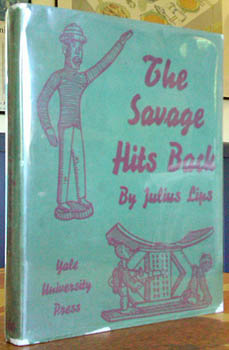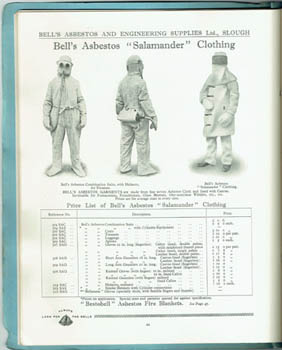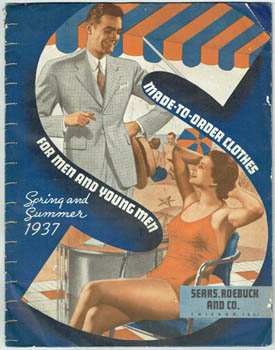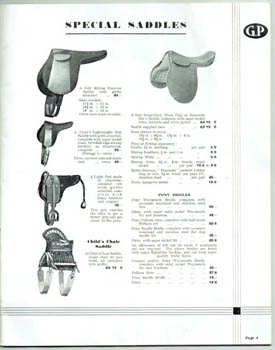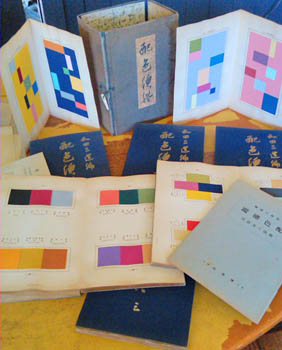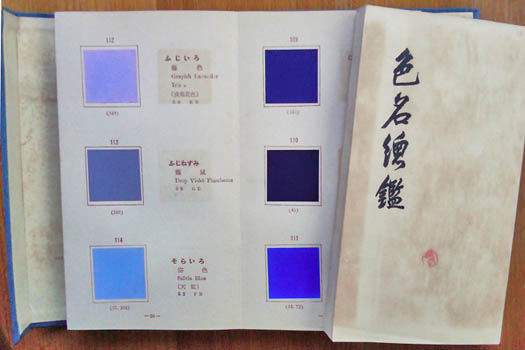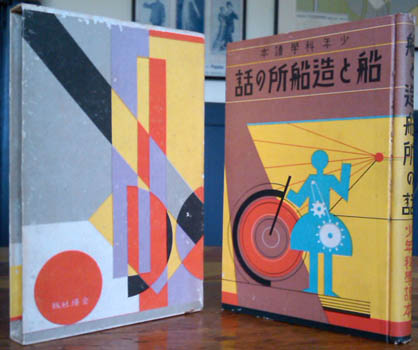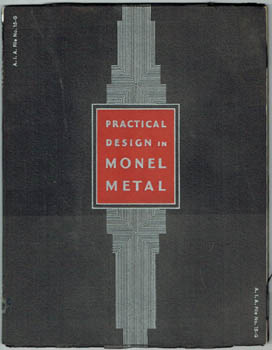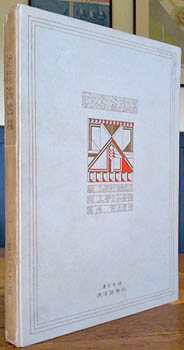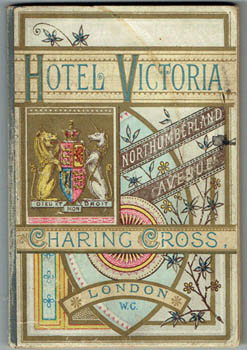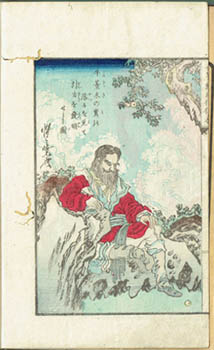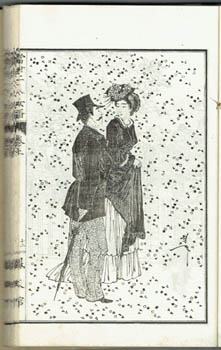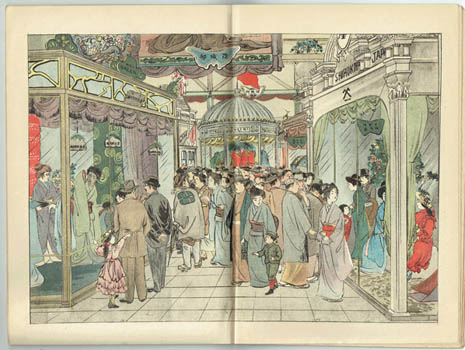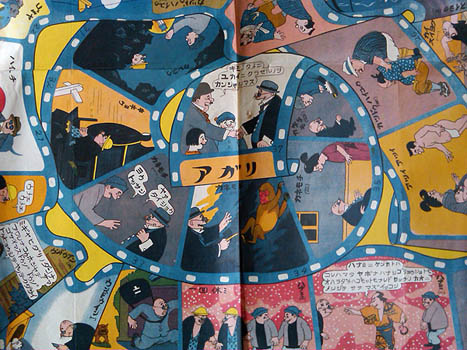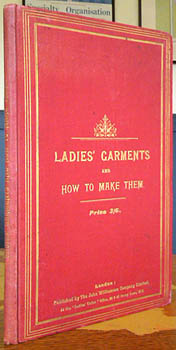These books haven't necessarily been uploaded to antiqbook yet so if you order through antiqbook and get a message claiming the book has been sold email in case that isn't true.
![]()
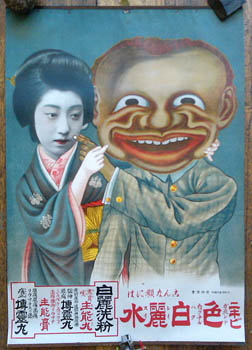
Teruha toiletry poster. 白麗水. [Hakuresui or Hakureisui]. A shop poster for Hakuresui toiletry to whiten the skin and remove blemishes. Osaka, Takegaki Shokai c1910. Colour lithograph 53x38cm on quite heavy paper with the original metal strips, top and bottom, and ribbon loop for hanging in a shop. Au$1350
Among the myriad images that use race superiority and fear to sell goods - particularly soaps, toiletries and cosmetics - this is the weirdest and most hypnotic that I've ever seen. The weirdness intensifies if you know that the model is Teruha, maybe Japan's most famous geisha and pin-up girl at the end of the Meiji and through the Taisho period. Born Tatsuko Takaoka, in this poster she is 14 or so and has possibly graduated from her apprentice name, Chiyoha. Sold by her father at 12, her virginity was soon sold to the president of the Osaka stock exchange and by the time she was 14 she had been engaged to one wealthy business man, promised to another and had a secret affair with an actor. The extended left pinkie finger must be a joke about her misguided sacrifice to love which earnt her yet another name: the Nine Fingered Geisha.
Before and after - or with and without - comparisons were nothing new in Japanese advertising. Neither were celebrities: courtesan prints sold patent medicines long before the Americans arrived and Bismarck adorned adverts for a patent syphilis cure that did for medicine what Bismarck did for Germany. Darkie - coon, nigger, whatever you want to call it - advertising images were obviously not unknown but neither can they have been familiar enough to be taken for granted and reproduced to the American and British formula in the way that the jazz age negro became a standard pattern to be played with by artists and designers in Japan as everywhere else. There is more than hint of a jovial tengu, spirit or minor god here, but for that suit.

ANSTEY, F. [ie Thomas Anstey Guthrie]. A Bayard From Bengal. Being some account of the magnificent and spanking career of Chunder Bindabun Bhosh, Esq. B.A., Cambridge, by Hurry Bungsho Jabberjee, B.A., Calcutta University, ... London, Methuen 1902. Octavo publisher's cloth with mounted illustration; eight plates by Bernard Partridge, 40pp publisher's list dated August 1902. A touch of browning and minor signs of use, a rather good copy. Au$150
First edition of this spanking example of comedy that can no longer be funny; a slur from the caption on the frontispiece to the very last word. Anstey specialised in fish out of water - or stranger in a strange land - situation comedy, often fantastic, and I get him mixed up with his imitator with a parallel pseudonym, R. Andom who specialised in identity exchange. Here we follow the adventures of our Indian hero in Oxford and highish society as portrayed by a fellow Anglophile and drawn by a last minute stand in for the desired Royal Academician, whose ignorance of things British needs constant correction. All this sparked a letter to the Spectator from an Andra Singha in September 1902 complaining that Anstey's mockery of Indian writings in English was too easy a target, tired and misguided. Anstey's mockery of Indians themselves went unnoticed.
![]()
You can email an inquiry or order securely through antiqbook
>LIPS, Julius E. The Savage Hits Back or the White Man Through Native Eyes. Yale University Press 1937. Small quarto publisher's cloth with paper title label, dustwrapper (this with a few small chips) ; xxxi,254pp, 213 photo illustrations and line drawings. A nice copy.
A signed presentation in 1937 from Lips to his "very dear colleague" Sterling Brown, African-American scholar and writer. Au$400
The dustwrapper of the English edition is more arresting but the dustwrapper of this is more political. First American edition, using the English sheets, published more or less concurrently - and uncommon in such good shape - of this remarkable book with a history that, if half of what Lips tells us is true, makes it even more remarkable. In March 1933 Lips resigned his directorship of the Rautenstrauch-Joest Museum in protest against the edicts of the new Nazi regime and found he "was the only 'Aryan' ethnologist to do so." What followed over the next year is the stuff of every nightmarish thriller about that period; threat, persecution and false accusation by a former student and a former assistant - now in control of the museum - the mayor of Cologne and the secret police in pursuit of his manuscript and photographs. "An uproar was produced by the simple fact that a Cologne professor had lying in his house a manuscript the theme of which was the criticism of the white race by their coloured brethren. In addition there were among the illustrations portraits of high German military and Government officials which were the work of blacks, one of the 'lower races'. The mere possession of the pictures was a crime against the State, how much more criminal the attempt to publish them!" The "idea of the illustrations had become a semi‑official mania; although only the students had seen them, it was now the State, i.e. the Nazi party, that wanted them." The mayor "had cultivated a feverish curiosity about the vanished pictures, which were supposed to be lurid with "nigger atrocities" and "insults to Hitler"."
Finally a moonlight flit with his pictures and manuscript on the eve of his arrest was his only option. This left his "wife as a hostage for the production of the manuscript" - which is where I hope Lips is being overly dramatic about the whole affair - while Lips made his way to London and found Lovat Dickson who agreed to publish before he had read a line of the book.
The book is revolutionary. It was the first time a mirror was held up in such a simple graphic way to the west who were shown how most of the world - the supposed savage world - saw them. And how keenly it saw them.
![]()
You can email an inquiry or order securely through antiqbook
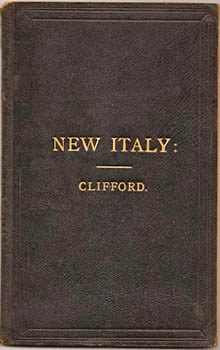
CLIFFORD, Fred. Chudleigh. New Italy: A brief sketch of a new and thriving colony founded and established by the Italian immigrants who were sufferers by the Marquis De Ray's New Ireland colonization scheme. Sydney, Govt Printer 1889. Large octavo publisher's flush cut roan, front cover titled in gilt; [6],30pp & folding map. The title is headed: 'Richmond River District of New South Wales'. As foolishly indulgent as it may seem for such a slender book the edges are marbled. Au$750
This settlement in north east New South Wales must be the first concentrated settlement of Italian agriculturalists in this country. Until recent years this particular aspect of the aftermath of the Marquis de Ray debacle was neglected in most things on the affair - Niau, the daughter of a French survivor, pretty well ignores the Italians in her history 'The Phantom Paradise'.
Irresepective of the appalling adventure that led the Italian survivors to the district, New Italy was possibly the most successful semi-utopian communal settlement in Australia. Clifford, who came across the isolated settlement by chance, gives the background, a good account of their virtues and achievements (extolled as models), and their names. His particular interest in viticulture and fairly prolonged discussion of it also makes this necessary for any serious collection of Australian wine books. Journalists who followed Clifford to New Italy were less enthusiastic about describing a thriving success but their criticisms were directed at the authorities, not the settlers.
![]()
You can email an inquiry or order securely through antiqbook
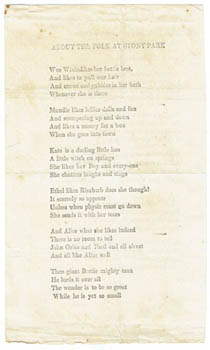
[SUMNER, Theodotus John]. About the Folk at Stony Park. n.p. [Melbourne c1869]. Single sheet 22x13cm printed on both sides. A bit rumpled maybe but a remarkably good survival. Au$150
A quite sweet comic poem, undoubtedly by "DAD" about the children, the dog and Grandma who likes to go to Geelong, in 12 quatrains that may have been printed on a small home printing press; if so, it's not badly set and evenly, if lightly, inked for an amateur job. It doesn't seem good enough for a well to do stalwart of Victorian society to have paid his local printer to run off.
No surnames - but that of a Mrs Grice - are given here but 'Stony Park' put together with the children's names - Winnie, Maudie, Kate, Ethel, Alice, Bertie and Annie lead us unmistakeably to Sumner, his home Stony Park in what is now Fitzroy/Brunswick (and quite a pile it was too) and his firm Grice, Sumner & Co.
Winnie, the first mentioned and youngest who grew up to be Alec Waugh's mother-in-law, is described as liking her bottle, pulling hair, crowing and gabbling, and as she was born in 1868 that pretty well dates this.
![]()
You can email an inquiry or order securely through antiqbook

KANT, Immanuel. Metaphysical Works of the celebrated Immanuel Kant, translated from the German, with a Sketch of his Life and Writings, by John Richardson ... Containing 1. Logic. 2. Prolegomena to Future Metaphysics. 3. Enquiry into the Proofs for the Existence of God, and into the Theodicy, now first published. London 1836 [but each printed for Simpkin & Marshall in 1819]. Octavo modern half calf; two engraved portraits (one for the first, the other for the third work), collective title and title for each work. A little browning here and there, a rather good, fresh copy. Au$1850
First English edition of the third work and re-issues of the original 1819 sheets of the first two. The Enquiry was also printed in 1819 but never published for some reason. Lack of interest easily explains the existence of unsold sheets being gathered together for sale (by Pickering?) in 1836 but not why the Enquiry was killed before birth. The title pages for Logic and Prolegomena each carry the 1819 Simpkin Marhsall imprint but are on different paper to the text.
Richardson was an old Kantian, he published the first translations of Kant into English in 1798 and apparently corresponded with Kant but otherwise remains in the shadows from what I can discern.
![]()
You can email an inquiry or order securely through antiqbook
>Okamoto Ippei. 漫画双六 [Manga Sugoroku]. Tokyo, Shufunotomosha 1929 (Showa 4). Broadside 64x94cm; colour printed. Folded, minor signs of use. Au$650
A splendid, large - on better paper than average at this time - and lively sugoroku - racing game - by the illustrator/cartoonist whose place in modern manga history is still being argued.
Issued as a New Year supplement to the magazine The Housewife's Friend, the game is an intriguing melange, to me, of the modern and traditional, whether in conflict or harmony or all round mocked I don't know. The winning post - the joyful family of plump plutocrats with both husband and wife looking remarkably like lucky gods - is the dream of the modern young woman being hatched from an egg in the upper right but she is not the starting point of the game. There seems to be several starting points. Did any young western woman ever dream of being rich and fat?
Okamoto Ippei began as a newspaper cartoonist for the Asahi Shimbun in 1912, travelled to the US in the twenties and brought back an enthusiasm for American comic strips which quickly spread through Japan. A prolific artist naturally, he has a long bibliography and much of it is found in scatterings in western libraries but I know of only one with a copy of this.
![]()
You can email an inquiry or order securely through antiqbook
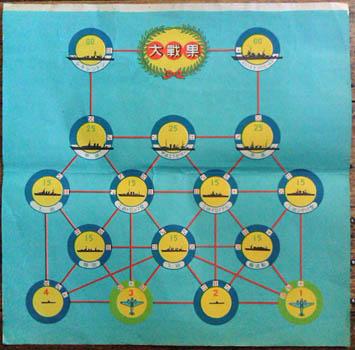
Paper Game. 大戦果 [Dai Senka]. n.p. n.d. [Japan 1942?]. Colour printed broadside 36x36cm. Folded but in very good shape. Au$90
A triumphant kid's war game in which the ultimate prizes are the battleships, HMS Prince of Wales and USS Lexington - sunk in December 1941 and May 1942 in battles north of Singapore and in the Coral Sea respectively. On the way the players - plane or submarine - win points by sinking a variety of enemy warships.
![]()
You can email an inquiry or order securely through antiqbook
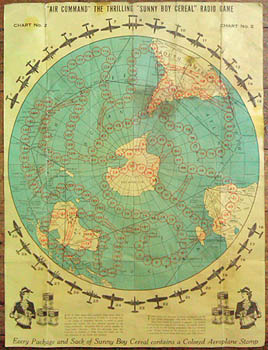
Paper Game. "Air Command" the Thrilling "Sunny Boy Cereal" Radio Game. n.p. n.d [Canada, Calgary? 1943]. Broadsheet 61x47cm colour printed on both sides - northern hemisphere on one side, southern on the other. Folded, rumpled, used but a very decent copy. Au$90
A kid's aviation game that was played to instructions on the radio. You wrote to Sunny Boy for your map and a warplane stamp album which was handy for winning cash prizes. Each week the number of one of the plane silhouettes round the globes was called and you could use your album to identify the plane. Each packet of cereal had a stamp. Any kid who needed help to identify a plane by its silhouette, though, wasn't even trying.
Sunny Boy began broadcasting the game in western Canada in late 1943 and while aircraft recognition was a large part of this geography and the future of aviation are at the heart of this rather than fighting battles. Battles were never far away - there seems little reason for Buna to be on the map but for the recent battle - but there are some pretty recondite choices. You didn't see Fanning Island, even misspelt, except on serious maps.
![]()
You can email an inquiry or order securely through antiqbook
>Catalogue - asbestos. Bell's Asbestos ... Slough. Bestobell. Asbestos and Insulation Products. The company 1931. Quarto publisher's printed wrapper; [80]pp, illustrated throughout. A little used. With the stamps of the Australian agent. Au$135
Useful for those who plot the ubiquity of asbestos in our lives if not the most lovable catalogue. But who could resist the Salamander fire suits? except maybe those who had to wear them. And if we ever need a reminder of the extent to which every human activity is little more than a game of Russian roulette then the existence of a fire blanket specifically made for cinema projection room fires will do it.
![]()
You can email an inquiry or order securely through antiqbook
>Catalogue - Men's suits. Sears Roebuck & Co. Made to Order Clothes for Men and Young Men. Spring and Summer 1937. The company 1937. Quarto publisher's illustrated wrappers (corner gone from the top corner of the front); 16pp, illustrated throughout and with some 60 mounted fabric swatches. A pretty good copy complete with the order forms and the four page brochure on how to measure yourself. Au$90
Clifton Webb, Robert Montgomery and Edward Arnold never looked so smart and you can be sure they didn't wear Sears Roebuck suits. I'm almost sure one of the models here is a young John Wayne. One of Wayne's biographers writes of the unhappy poor boy reading Sears Roebuck catalogues cover to cover and dreaming of being able to afford everything in them. A dream shared by countless Americans, young and old, for decades.
![]()
You can email an inquiry or order securely through antiqbook
>GAUTIER, Judith & R. Isayama. La Source d'Or de la Sante. Paris, Phosphatine Falieres [c190-?]. Oblong octavo publisher's printed wrapper (a bit browned or mottled); [28]pp with 12 colour illustrations by Isayama. A bit used, a very decent copy. Au$150
A chaming bit of fakery. The makers of Phosphatine - the patent baby food - enlisted the distinguished scholar and translator of things Chinese and Japanese, Judith Gautier, to create a traditional Chinese folktale in which the survivor of a shipwreck manages to get off with some of the cargo and is rescued and nursed by a local Mandarin and his family. Pausing only to change into a suit which must have been in his uniform pocket he repays the family by introducing them to Phosphatine. This golden source of health soon works its magic among the neighbours, word spreads and by the end a whole generation of healthy Chinese babies is made possible.
The illustrator is a supposed Japanese artist in Paris. The new Asian Benezit cites a Reikichti - which is surely a mispelling - Isayama exhibiting at the 1900 Exposition but I can't find any work other than the couple of books done with Gautier. A search of all likely catalogues found one copy of this - in Italy, not France.
![]()
You can email an inquiry or order securely through antiqbook
>Catalogue - saddlery, harness, luggage etc. George Parker & Sons, London. Parkers Saddlery - Harness - Leather Bags - Trunks [cover title]. The company [c1930?]. Quarto publisher's printed wrapper (a bit dusty); [3].49pp, illustrated throughout. Mildy used. Au$75
Not just saddles, harness and suitcases but everything else for the horse, the stable and their owner, from attache cases to yearling sheets taking in hunting flasks on the way. I'm not surprised by the Australian buckjumping and colonial saddles but wonder how they maintained a supply of second hand colonial saddles and I'm bemused by the highly decorated cowboy saddle and fringed schappes for sale in St Martins Lane.
![]()
You can email an inquiry or order securely through antiqbook
>Catalogue - hearses. Merts & Riddle, Ravenna, Ohio. Merts & Riddle, Coach and Hearse Builders. Ravenna, printed by S.D. Harris [188-?]. Oblong octavo publisher's illustrated wrapper; 50pp, full page wood engraved illustrations throughout. A remarkably good copy. Au$300
Ravenna was clearly no one hearse town in the later 19th and early 20th centuries. Merts and Riddle bought their employer's coach building company in 1861 and expanded into hearses a decade or so later. When Merts left in 1891 the company became Riddle Coach & Hearse Co. This is the earliest catalogue - dated "1880 or so" - in the collection of Thomas Riddle, descendant and company historian. The catalogues at the Huntington with a conjectured date of 1875 aren't. Romaine did not see any Merts & Riddle catalogues.
![]()
You can email an inquiry or order securely through antiqbook
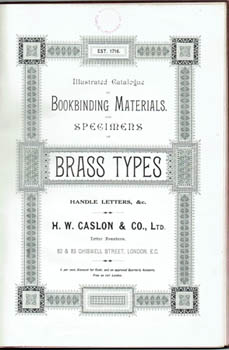
Catalogue - Bookbinders' tools. H.W. Caslon, London. Illustrated Catalogue of Bookbinding Materials, and Specimens of Brass Types, Handle Letters, &c. H.W. Caslon & Co., Ltd. London, the company [c1890 - 1900?]. Quarto publisher's cloth blocked in black; 70pp, illustrations and examples throughout. Ex library, but not offensively so and clearly never touched once the librarians had done with it - a rather good, bright copy. Au$850
All catalogues of bookbinding equipment of any decent age are hard to find and this, even though it's from the venerable and far-reaching firm of Caslon, is no exception. Hunting through the libraries of the world I found two or three entries for a Caslon catalogue from sometime after 1900 with a few more pages than this but no unequivocal copy of this one. I'll claim this is earlier without too many qualms. It offers everything from large machinery to the smallest hand tool, an extensive range of brass type and handle letters, rolls, pallets, corners and decorations.
![]()
You can email an inquiry or order securely through antiqbook
>Wada Sanzo. 配色総鑑 [Haishoku Sokan]. Tokyo, Hakubisha 1933-34 (Showa 8-9). Six volumes (198x130mm) of plates in publisher's cloth titled in gilt; a 40 page booklet in wrappers and four colour sample plates on two folded card leaves all together in publisher's folding case with clasp and title label. The plate volumes constitute a total of 348 accordian folding card leaves with mounted colour samples arranged in pairs in the first two volumes, trios in the next two and quartets in the last two. The colour samples are all mounted and captioned in Japanese and English. The outer case somewhat browned and shabby but solid, the two separate cards browned and touches of browning around edges of the other other card mounts. A few annotations here and there. A most respectable set and extra complete with loose printed slips - publisher's announcements and an errata slip; virtually all loose tissue guards present. Au$2850
First edition of this fabulous dictionary or grammar of colour - there is a recent reprint; a sophisticated synthesis of western and Japanese theory and usage. Wada's place in Japanese art has been assured since his 1907 prize winning painting Nanpu - which in western terms sits somewhere between Winslow Homer and beefcake pinup, much as Winslow Homer did - but Wada got more interesting as he got older and a return to Japanese painting in the twenties along with his design work and colour research pushed along an increasingly assured generation of artists with a grasp of west and east and an intent of their own.
Wada's name was unfamilar in the west until recent years but you don't have look far to see his ideas at work, spread by second and third hand borrowings. Unknown to the amazingly bad Osborne Books on Colour Since 1500 (as a book a waste of ink and paper, as an ebook a waste of electrons); Yale has a copy in the Faber Birren colour collection and OCLC finds no other copy outside the National Diet Library. Neither can I in all the places where I can think to look.
![]()
You can email an inquiry or order securely through antiqbook
>Wada Sanzo. 色名総鑑 [Shikimei Sokan]. Tokyo, Shunjusha 1931 (Showa 6). 195x115mm publisher's case with title label with 160 mounted colour samples on 56 accordian folding leaves and wrappered book; 178pp and some tables (two folding). Some browning and still a very nice copy. Colour samples named in Japanese, English and occasionally French or German; two of the tables are multi language lists of colour names. The top edge of both parts are gilded and the apparently plain paper lining of the case has a pattern of transparent glazed shapes printed on it. Au$375
First edition of Wada's first serious attempt at colour nomenclature. Wada, though at the top of the art ladder in Japan insisted on pursuing new directions and founded the Japan Standard Color Association, now the Japan Color Research Institute, in 1927; in these early years science, art and aesthetics went hand in hand.
Yet another significant book missed by the peurile Osborne Books on Colour Since 1500.
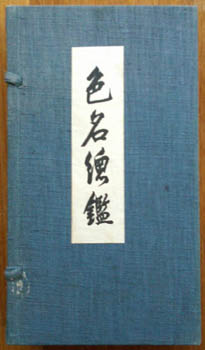
![]()
You can email an inquiry or order securely through antiqbook
>AUDSLEY, W. & G. [William & George]. Polychromatic Decoration as Applied to Buildings in the Mediaeval Styles. London, Sotheran, 1882. Folio publisher's gilt cloth (wear to tips); [8],32pp and 36 chromolitho plates interleaved with descriptive text. Light browning, quite a good copy. Au$450
Careful and plain descriptions and practical advice accompany the sometimes spectacular designs. A chart offers the colours and tints most suitable for decorative painting and patterns are grouped for specific wall areas and features. At the end are four plates of alphabets.
![]()
You can email an inquiry or order securely through antiqbook
>Matsuyama Shisui. 船と造船所の話 [Fune to zosensho no hanashi]. Tokyo, Kinto-sha 1932 (Showa 7) Octavo publisher's colour illustrated boards and slightly rubbed slipcase (a hint of rubbing, a small surface chip from the top of the spine); 12,244pp, illustrated title, three photo plates, two folding plans, illustrations and photos through the text. An outstanding copy. Au$675
While the cover designer almost nods to the subject of the book and the title page lets you know there's technical stuff to follow, the outside and the inside, are only connected by the spirit of modernity and progress. Inside we find a worthy, serious book on shipbuilding for the younger reader, specifically boys - and damn serious boys at that. It looks as thorough and as technical as most adult monographs for English readers.
The Sanko Library has a copy and that's all I can find anywhere. I want to know who designed the cover, I can't find a credit in the book.
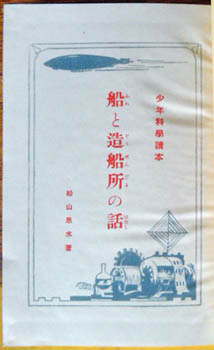
![]()
You can email an inquiry or order securely through antiqbook
>[HEINE, Johann August]. Traite des Batiments Propres a Loger les Animaux, qui sont necessaires a l'economie rurale;... Lepizig, Voss 1802. Folio (38x27cm) contemporary quarter calf and mottled boards (rebacked with the original spine preserved); xii,72pp and 50 engraved plates including the frontispiece - plans, elevations etc. Foxing, still a crisp copy. Au$1975
First edition - a German translation appeared a couple of years later - of this handsome, thorough, expert treatise on the architecture of animal husbandry. Heine wrote with an even hand on architecture and rural economy or, as here, both. The book begins with a plan and elevation for a house and estate and continues in sections: stables and all the other varied structures for horses; cows; pigs; sheep; birds, ducks and geese; bees; silkworms; and dogs. The bee and silkworm sections go well beyond architecture and could be self contained monographs on apiculture and sericulture.
These are no rustic sheds. These are substantial and considered - quite severe - neo-classical buildings, any one of which would be desirable real estate now. I don't remember another farm building pattern book which insists on applying rules of proportion.
![]()
You can email an inquiry or order securely through antiqbook
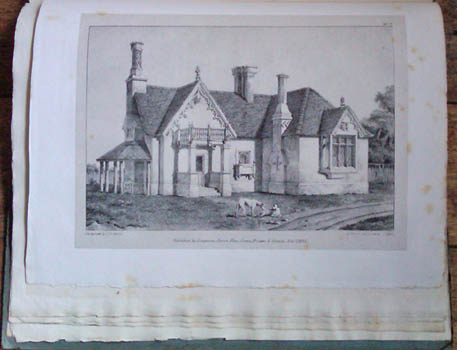
HUNT, T.F. [Thomas Frederick]. Half A Dozen Hints on Picturesque Domestic Architecture in a Series of Designs for Gate Lodges, Gamekeeper's Cottages, and other Rural Residences. London, Longman, Hurst 1825. Small folio, uncut in publisher's boards with printed label on the front (rebacked); [32]pp and 12 litho plates. Foxing but an appealing copy of the issue with proofs on India at 21/-, as opposed to 15/- for standard copies. Au$350
First edition of Hunt's first book, very much an essay in picturesque nationalism, with designs for nine buildings.
![]()
You can email an inquiry or order securely through antiqbook
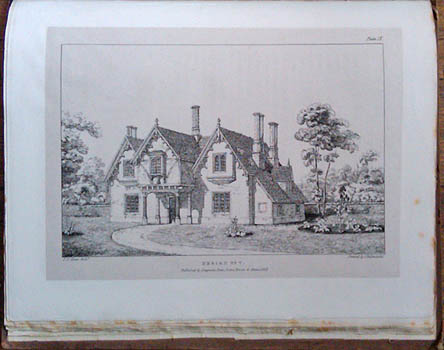
HUNT, T.F. [Thomas Frederick]. Designs for Parsonage Houses, Alms Houses, Etc with Examples of Gables, and Other Curious Remains of Old English Architecture. London, Longman, Rees, Orme 1827. Quarto, uncut in publisher's boards with printed title label on the front (rebacked); [8],34pp and 21 litho plates. Some foxing and a mild tide mark at the bottom of a couple of plates, still a pleasing enough copy. The plates, printed by Hullmandel, are on India, mounted, possibly denoting the proof issue. Au$250
The sequel to Hunt's 'Half a Dozen Hints' (1825), still firmly planted in a pure old England unconfounded by the Gothic. He makes the pointed point that his renderings are uncluttered and unsweetened by "factitious" effects. They are as built, not as they might appear with years of ivy, gardens and mellowing. We need look no further than colleague P.F. Robinson for such abject fiddling.
![]()
You can email an inquiry or order securely through antiqbook
>Catalogue - architectural metal. International Nickel Co. New York. Practical Design in Monel Metal for Architectural and Decorative Purposes. The company 1931. Quarto publisher's printed wrapper (spine a little worn); 72pp, numerous photo ills and measured drawings. Stamps of the Selznick International Pictures Research Dept - and many a high deco film set owes a lot to Monel Metal. Au$150
A moderne catalogue purveying the luxurious gleam and sharp lines of nickel steel which is the epitome of American art deco; some pages are highlighted with silver frames. All the examples illustrated are identified - and the architects named - and range from skyscraper foyers and banks to decoration in the homes of the smart set. At the very end are the proverbial kitchen sinks needed to complete any self respecting architecture catalogue.
![]()
You can email an inquiry or order securely through antiqbook
>Frank Lloyd Wright. Sugawara Eizo. 新橋演舞場 [Shinbashi Enbujo - Shinbashi Theatre]. Tokyo, Koyosha 1926 (Taisho 15) Small quarto publisher's decorated white boards blocked in gilt and red, printed card slipcase (this with some small repairs and a little piece missing; [2],10pp and 71 plates (two colour plates with mosaic designs). Spine a bit browned and rubbed along the hinges; a very good copy of a smart book in a hardly sensible binding. Au$950
This could be called 'Frank Lloyd Wright's Tokyo Theatre' for it is, top to toe, Wright at his most Japanese. Even the red and gold design on the cover is pure Wright. Wright did design a never-built theatre while in Tokyo so despite his aversion to sharing credit, or fees, perhaps he had some satisfaction in seeing the theatre of his colleague and acolyte Eizo Sugawara realised so exactly in his own image. Following the colour plates of mosaic designs are measured drawings and plans and photo views of the exterior and interior, where Wright is particularly rampant, with satisfying detail.
The theatre lasted longer than Wright's Imperial Hotel by a few years - it was rebuilt in 1982 - and this monograph seems to be the only real record that survives. As no drawings or plans for Wright's Ginza theatre are known to survive, this is as close as we get to his ambitions for a Japanese theatre.
OCLC finds two locations outside Japan, neither specialist architecture or design libraries, and a search of umpteen likely catalogues found no more.
*Click on the picture to see more.
![]()
You can email an inquiry or order securely through antiqbook
Tokyo after the earthquake, as it it should be
>Hayashi Tadaichi. 少年帝都復興双六 [Shonen Teito Fukko Sugoroku]. Tokyo, Nihon Shonen January 1924 (Taisho 13). Colour printed broadside 55x79cm. Folded, some small holes and tears repaired; a pretty good copy. Au$485
Have you seen a better piece of visionary urban planning? This sugoroku - racing game - accompanied the New Year issue of Nihon Shonen (Japanese Boy) and what better way to mark the new year than rebuilding the freshly devastated Tokyo along utopian lines? The title more or less translates as Boy's Reconstruction of the Imperial Capital and I'd move there in a flash.
This has been thought out. Public transport is a marvel with canals, aerial cable cars and trains tearing round the city and on and off ferries; the airport is sensibly at flight level, which must save enormous amounts of fuel; I think the floating palace is an overnight shuttle to America. Public health and safety is well considered: the fire brigade operates from a tower with a water cannon that can reach across the city to extinguish fires and the hospital will come to you, no matter the terrain. Culture and sport are catered for and the traditional at heart will be comforted to see industry over on the wrong side of the tracks, well away from the houses on the hill, where it belongs. Two essential Tokyo survivors are the start and finish: Tokyo railway station and the imperial palace. I don't approve of the alarm on the clock tower but no-one can be unimpressed by the solar heating plant. Boy or not, this is the town for me.
*Click on the picture to see a couple more.
![]()
You can email an inquiry or order securely through antiqbook
>New York. Humphrey Phelps. The Great Metropolis. Phelp's New York City Guide ... NY, Gaylord Watson 1874. Small octavo publisher's printed orange boards (some scuffing); 72pp and large folding handcoloured map (405x720mm), wood engraved frontispiece and illustrations throughout. The guide book is a bit used but there are only a couple of small holes in the folds of the map, so a surprisingly good crisp copy. Au$375
"From this great centre radiates - by telegraph, steamers, and railroads - new fashions and follies, daily ... and what is said or done is sought after with eagerness by the thirty millions of freemen," says the introductory note. Whatever else has changed in the city, smug self regard hasn't budged in a hundred and forty years.
![]()
You can email an inquiry or order securely through antiqbook
>Hotel Victoria, Northumberland Avenue, Charing Cross, London. The company (printed by Waterlow Bros) [c1890]. Small octavo publisher's colour illustrated boards (a bit rubbed and marked); 58 & 12pp of adverts, 10 tinted plates showing the interior. Some stitching coming loose but still a pleasing enough copy. Au$150
A stylish little handbook with all the esteemed guest could need: tarriffs, telegraph codes, cab fares, exchange rates, consulates, theatres and so on. The Hotel Victoria is gone but the building survives, called Northumberland House for a time.
![]()
You can email an inquiry or order securely through antiqbook
>Isaac Newton. Kawanabe Kyosai & Nakagane Masahira. 世界風俗往来 - 外篇 [Sekai Fuzoku Orai - gai hen]. Tokyo, 1873 (Meiji 6). 230x155mm publisher's wrapper (missing the title label); two full page colour woodblock prints by Kyosai. Some smudges that suggest it may have read by a member of the working class; a bit of worming in early pages, nothing serious; a pretty good copy. Au$725
Could there be a better portrait of Isaac Newton? I doubt it. Where else have you seen the fierce intellect and the majestic dignity of the warrior king of science so well embodied? In one piercing moment he has seen into the secret heart of all things, made his ruling and brought order to an unruly universe. Having decreed how that apple had moved through space and where it now rests he defies it to move again.
The other picture is of the young James Watt making his first steam powered discoveries. The myth of child Watt and the kettle seems to date from 1839 with Arago's Eloge of James Watt and in picture a few years later; the earliest I found is an 1844 wood engraving in Jerrold's Illuminated Magazine illustrating a fanciful retelling by Angus Reach. Kyosai's picture is closer in form to Buss's 1845 painting than Marcus Stone's 1863 reworking of the story but it is clear that he has worked - as with Newton and the apple - from the story rather than any pictorial model.
There is a complementary 1872 book with much the same title as this introducing the west but each is a complete and separate thing. OCLC finds only the Diet Library copy of this but Waseda University has a sadly chewed copy they illustrate online.
![]()
You can email an inquiry or order securely through antiqbook
Suppressed surveyors?
>Giichi Akita. [The entry used by Worldcat names him Hodo Akita]. [In Japanese] 算法地方大成 - Sanpo Jikata Taisei. Tokyo, Kitajima Junshiro &c 1837 (Tenpo 8). Five volumes (25x18cm) publisher's wrappers; 4,156 double folded leaves, numerous woodcut illustrations. A spot of worming in the first cover and a touch in another volume, a rather good set. Au$350
First edition of this manual of land management and surveying, published at a troublesome time in Japanese history: the 1830s brought a movement, fiercely resisted by the authorities, towards the adoption of western science and technology and, relevant to this book in particular, a period of horrendous drought, famine and unrest in rural Japan. Land surveying was primarily concerned with taxation and, before the Meiji reforms, accurate measurement was not only unimportant but unwanted. The extent and value of land was a matter for negotiation.
The intricacies of Japanese land surveying in the early modern period demand long learned essays - and after reading a couple I'm none the wiser - but what is clear is that this book is a major work in the history of rural engineering, survey and management. It was also problematic for the authorities: "problems in surveyor education were aggravated by government censorship. Bakufu officials did not want administrative uses of survey techniques discussed in public. Under the guise of 'respect authority; despise the people (kanson minpi),' the mysteries of official practice were not to be released to the public domain." (Brown: A Case of Failed Technology Transfer - Land Survey Technology in Early Modern Japan; 1998).
The authorities did suppress or attempt to suppress the Sanpo Jikata Taisei; Brown refers us to the preface of the 1976 reprint of this book for details and I came across another reference that claimed the woodblocks were destroyed. This seems fairly scarce outside Japan - the title is well represented in western libraries but once we discard the 1976 reprint I found only two libraries with originals through Worldcat.
![]()
You can email an inquiry or order securely through antiqbook
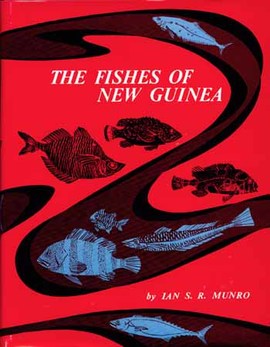
MUNRO, Ian S.R. The Fishes of New Guinea. Port Moresby 1967. Large octavo publisher's cloth and dustwrapper; 650pp & 84 plates (6 colour), illustrations through the text. Unopened in the original packing box. Au$50
![]()
You can email an inquiry or order securely through antiqbook

STOCKTON, Frank R. A Bicycle of Cathay. NY, Harpers 1900. Octavo publisher's decorated green cloth; numerous illustrations by Orson Lowell. A couple of margins roughly opened but an excellent copy. Au$50
First edition of this charming bicycling romance; the hero seems to rarely be off his bike unless going to the aid of charming bicyclistes.
![]()
You can email an inquiry or order securely through antiqbook

HORNUNG, E.W. [Ernest William]. Witching Hill. NY, Scribner 1913. Octavo gilt cloth; illustrations by F.C. Yohn. An excellent, bright copy. Au$150
First American edition, contemporaneous with the London edition - both arrived in February I believe.
![]()
You can email an inquiry or order securely through antiqbook
King Lear in modern Tokyo
>Shakespeare. Gakkai Yoda, Shuto Osada &c. 当世二人女婿 [Tosei Ninin Muko; also transcribed as Tosei Futari Muko - this translates as something like Two Son-in-Laws of Today]. Tokyo, Hobunkan 1887 [Meiji 20]. Two volumes, 23x15cm, publisher's illustrated wrappers with title labels; one full page and six double page woodcut illustrations by Yoshitoshi. A bit of worming to five leaves, not serious; a nice copy. Au$800

Being illiterate has never been an impediment for a bookseller but sometimes it does make it hard to explain clearly what you are selling. I have read everything I can find in English on Shakespeare in Meiji Japan. There's quite a bit of it and it all pretty much repeats the same story established nearly a century ago. Three translators are fleshed out to degrees that depend on which is the focus of the historian and the rest brushed past. Gakkai Yoda was something of a leviathan in Japanese letters, theatre and culture but no-one writing in English has yet tackled his Shakespeare connection. His diaries were published in twelve volumes not so long ago so there must be plenty of material there.
Shakespeare began appearing in Japanese in newspapers in the 1870s, as fragments and retelling from Lamb's Tales. The first complete translation proper was of Julius Caesar in 1883, published in instalments in a newspaper and as a book in 1886; the first performance of a play was an adaptation of The Merchant of Venice in 1885. Hamlet, The Merchant of Venice and Julius Caesar were the favourites for the first few years and the plays were remodelled as Japanese dramas.
This is translated from a French version - this is where Shuto Osada played his part, he was the translator from French - not directly from Shakespeare; it is set in modern Tokyo - had anyone anywhere in the world consciously done this? - and there must be a good reason why.
OCLC has seven entries for this book so it must be common, you'd think. The seven entries together locate three copies, one outside Japan.
![]()
You can email an inquiry or order securely through antiqbook

Sugar & alcohol. Report From the Committee on the Distillation of Sugar and Molasses. [Second ... Third ... Fourth Report ... ]. [London], Ordered to be Printed 1808. Foolscap folio, very good in later cloth (marked and a bit stained); [4],420,[2]pp. With printed title and leaves at the front and end stating this to be the Home Office copy. Titles for each report but continuously paginated. Au$450
Is there any part of the world that in modern times has not been steered by drugs? Here we have two of the biggies - sugar and alcohol - and the dire effect a dramatic drop in the price of sugar had on Britain's wealthiest - the billionaire class - the owners of West Indian sugar plantations. Add to that the possibly rational fear of a grain shortage due to the situation in Europe and you have the makings of a governnment sponsored monopoly on alchohol production for the sugar industry. I say possibly rational fear of a grain shortage; that was the approach taken by the majority of this Committee but it was fiercely disputed by the corn and barley growers of Britain and their representatives who claimed that the Committee had been rigged and MPs from the barley counties purposely excluded.
Maybe the two most powerful influences on government are at work here: very rich men and tax. I've read that nearly 40% of Britain's taxation then came from alcohol and its ingredients and there are some fearsomely abstruse pages here calculating the adjustments needed to maintain revenue without forcing up the price of drink enough to affect consumption. Until the end of the 18th century sugar and alcohol ran a global perpetual motion machine. Ships carried slaves to America and the West Indies and returned with rum and sugar, then shipped on to Britain's other colonies and markets. Alcohol distilled in India could be shipped further east - even to Sydney by the end of the 18th century. And where ready-made drink couldn't be had, sugar was even more essential. So, to many, the sugar crisis and the newly enacted abolition of the slave trade (the trade, not slavery itself) was a threat greater than any invasion by Napoleon.
Most of this weighty report is evidence; from lofty experts like Arthur Young and from barley farmers who almost always flatly contradict the experts; from highland distillers and the Irish equivalent of The Untouchables - Major Bellingham Swan tells us that in one night he seized 101 illicit distilleries and barely scratched the surface in that area. Merchants explain how the import of French brandy continues, the war is no impediment; West Indian merchants and planters explain why trade with the United States should cease and why it should be expanded; all planters are positive that their sugar and rum are superior and still unprofitable while a London merchant tells us that falling prices and the glut are due to a drop in quality; a Jamaican planter explains that you need to run in your new negroes carefully, don't push them hard until they are "seasoned". The best run estates have the highest number of "negroes and stock" - ie cattle.
![]()
You can email an inquiry or order securely through antiqbook
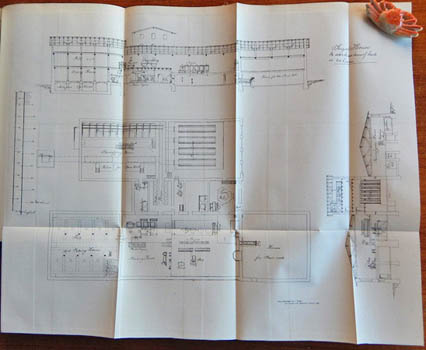
Sugar - the next tobacco
Sugar. Manufacture of Beet Root Sugar. Copy of two despatches from the Agent-General ... with estimates of sugar-houses, plans, drawings of machinery, etc. Melbourne, Govt Printer 1871. Foolscap, disbound in a modern plain wrapper; 15pp and eight litho plates (three folding). Au$200
The foundation of a sugar industry in Victoria, an attempt to match the rapidly burgeoning cane sugar industry of NSW and Queensland, was no great success. The Victorian Beetroot Sugar Company was registered in November, crops were planted near Geelong, a mill built nearby and plants built in Melbourne. By 1874 the mill was closed. The fault lay with the quantity and quality of crop not the technology and seems to have remained so in later attempts to create a southern sugar industry.
This report contains information gathered for the Warnambool Beet-root Sugar Manufactory giving plans and estimates of plants for works of two capacities. Pretty appealing and useful for the student of industrial architecture, manufactures and machinery. And sugar.
Sugar is the coming tobacco so the prescient should be carving out their positions
now for the boom to come: analysis, publicity, argument, crusades ...
![]()
You can email an inquiry or order securely through antiqbook

Homoeopathy. The Medical Telephone: containing hints on the preservation of health. Notes on nursing ... Plain directions for treating diseases. Ambulance lectures ... Hobart, The Homoeopathic Pharmacy 1883. Small octavo publisher's flushcut printed limp cloth (a hint of flecking); 116pp, a fair amount are advertisements. An excellent copy. Au$250
A neat little book with a neat title. When I first came across a copy of this, many years ago, I wondered whether there were any telephones in Hobart in 1883 but now, with online research, I find that Tasmania embraced the telephone early and 1883 saw telephone exchanges opened in Hobart and Launceston. In fact, according to Tourism Tasmania Australia's first phone call was a long distance call made in Tasmania two years before Bell got his telephone working.
This was a rare book for a long time; Ferguson missed it though it fitted his specifications for inclusion and Ford cited three copies, all in Tasmania. Then it became temporarily unscarce when a small cache of copies was discovered some years ago but now it's back to being a scarce book.
![]()
You can email an inquiry or order securely through antiqbook
>Exhibition - Tokyo 1907. 風俗画報 . 東京勧業博覧会図会 [Special number of Fuzoku Gaho devoted to the 1907 Tokyo Industrial Exhibition]. Tokyo 1907. Small quarto publisher's illustrated wrapper (spine worn); four double page plates (two colour), one tinted full page plate, b/w photo illustrations. A bit used but a pretty good copy. English translations of the plate captions on typed slips are loosely inserted. Au$175
The Fuzoku Gaho (1889 - 1916) was Japan's first graphic magazine. I'd like to know who the artist was of some of these plates, they masterfully capture the eagerness for the new, the wonder, the distractions, the shared delights, and the weary resignation of some parents.
The 1907 exhibition was conceived as an international exhibition but this ambition fizzled due to lack of enthusiasm, if not nerve, on the part of officialdom. Nonetheless this was big stuff, expansive in its inclusion of technology, culture, the arts and popular entertainment - introducing not one but two ferris wheels to Tokyo. It did pretty good business, atttracting some six or seven million visitors.
*Click on the picture to see a couple more.
![]()
You can email an inquiry or order securely through antiqbook

Chung Teong Toy. Ah Toy v. Musgrove. A copy of the report of the arguments and judgment in the case of Ah Toy v. Musgrove - Supreme Court of Victoria. Melbourne, Government Printer 1888. Foolscap, excellent in a modern plain wrapper; 164pp. Au$750
A quick dash through Quick and Garran's Annotated Constitution reinforces the sense of the momentous that surrounds this case. Toy v. Musgrove appears again and again cited as a "great" and "celebrated" case. Chung Teong Toy, a thwarted Chinese immigrant who arrived in Melbourne on the Afghan in April 1888, brought his case - backed by the Chinese Residents Association - against Musgrove, the Collector of Customs, for refusing to accept payment of the poll-tax of ten pounds demanded from Chinese immigrants. Without getting too bogged down in details Musgrove's defence was that he had been ordered to refuse entry to all the Chinese on the Afghan. The Supreme Court found - four judgments to two - in favour of the plaintiff and ruled that the Colony did not have the right to exclude aliens. One of the Justices - Justice Williams - was reluctant to concur; it left the colony "in this most unpleasant and invidious position", unable to prevent "the scum or desperadoes of alien nations from landing ... whenever it may suit them."
This of course was unacceptable and an appeal was made to the Privy Council. In the meantime the colonies used quarantine regulations to exclude Chinese immigrants where they could and quietly let in some handfuls where they couldn't do otherwise. Amongst the outrage and furor the suggestion was made that the authorities knew they were acting illegally; a sardonic Melbourne journalist wrote, "But isn't it a curious thing that our authorities should have been induced to go to illegal lengths under the spur of excitement and public clamour. I am told privately that at the time they were warned by council that they were exceeding the limits of their constitutional prerogative, but they felt so sure of having the public at their back that they took the risk. And now an opium-smoking, yellow-skinned Mongolian has given them a lesson they (or rather the country) will have to pay for to a pretty tune." (from the Traralgon Record, 14 Sept 1888).
The appeal to the Privy Council not only succeeded in 1891 but, as I understand it, fortified the bastion of government immunity by refusing to accept that an alien "can, in an action in a British court, compel the decision of such matters as these, involving delicate and difficult constitutional questions affecting the respective rights of the Crown and Parliament, and the relations of this country to her self-governing colonies." It should be noted here that I came across this quote not by reading the Privy Council decision but reading the summary of 'Fong Yue Ting v. United States' in the US Supreme Court in 1893.
Saddest from this distance is that, reading of the activities of the Chinese Residents Assocation, it appeared to many that progress was made: the short-lived victory of this case and the grudging admission of those handfuls of Chinese immigrants seemed a great step forward. Of course all colonial governments doubled their efforts and collectively triumphed with the White Australia Policy come federation. What I can't find among the thousands of words written about this case is what happened to Chung Teong Toy. Trove finds three copies of this, two dated a century wrong.
![]()
You can email an inquiry or order securely through antiqbook
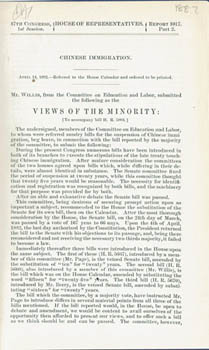
Chinese in America. Chinese Immigration. Mr Page from the Committee on Education and Labor, Submitted the following Report ... [with] Mr Wills ... Submitted the Following as the Views of the Minority ... [Washington, Government printer] 1882. Octavo disbound, the pair together in modern plain wrapper; 2pp & 6pp. Actually two copies of the Minority Report here - making this near a two for one deal. Au$75
You might think that the dissenting minority here object to the racist invective and punitive measures contained in the Committee report on the Chinese Immigration Bill that the Committee instructs both houses to pass without debate and of course you'd be wrong. A bill excluding the Chinese for a mere ten years will do nothing to stem the pernicious invasion and other measures in the bill weaken even further protection against the evil tide. The minority committee members will, however, overlook the dismantling or watering down of punishments if the period of exclusion is extended to at least fifteen years.
![]()
You can email an inquiry or order securely through antiqbook
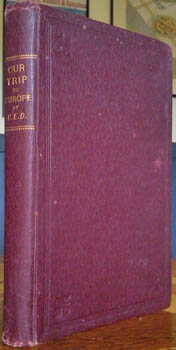
DAVIES, Hon. C.E. [Charles Ellis]. A Trip to Europe. Hobart, 'The Mercury' 1900. Octavo publisher's maroon cloth; viii,88,[2]pp; plates and photo illustrations. Some signs of use: tips rubbed, a bit loose, but a very decent copy. Au$30
Like the works of most colonial Australian travellers outside Australia, this is pretty much a private production. Some of it had appeared in the Hobart papers and Davies claims that the kind reception of those pieces led to him having this book run up. Very few of these travel accounts are less than dreadful - and this being a politician's trip scared me off. Still, it can be argued that Australian views of the greater world should not go unnoticed.
![]()
You can email an inquiry or order securely through antiqbook
>Sugoroku. 子乗物双六 [Ko Norimono Sugoroku]. Tokyo, Seugaku Sophomore, Ist January, 1930 (Showa 5). Colour lithograph broadside, 54x78cm; Folded, a nice copy with playing pieces intact in the left margin. Au$350
An exciting and vivid jaunt around the world and all forms of transport is the theme here. This was the New Year treat that came with the magazine Seugaku Sophomore (for the second year of primary school).
I don't know who those two kids are but they never aged and, with updates in fashion and style, seem to have been on a ceaseless whirl of travel and adventure ever after. For decades new but the same sugorokus appeared. The zeppelin vanished of course, square automobiles became sleek cars, trains went diesel and electric and aeroplanes became jets, and on those kids went. Perhaps they learnt early what many idle wealthy globe trotters know: that a diet of fine demi-sec and pure cocaine keeps you young forever.
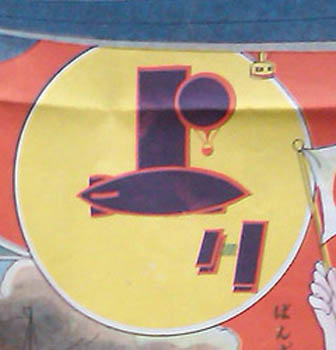 上り
上り ![]()
You can email an inquiry or order securely through antiqbook
>Aso Yutaka. ノンキナトウサン出世双六 [Nonki na Tosan shusse sugoroku]. Tokyo, Hochi Shinbunsha January 2 1925 (Taisho 14). Colour illustrated broadside game (54x79cm); folded, mild signs of use. With the circular portraits of the characters down the side which could be cut out and used as game pieces. Au$650
The new year extra from the newspaper Hochi Shinbun starring Japan's first serial comic strip hero Nonki Na Tosan - usually translated as Easy-going or Lazy Daddy - who first appeared in regular comic strips in the paper the year before. He owed some debt to Jiggs of Bringing Up Father but uncle Nonto was a thoroughly Japanese scapegrace and loafer who quickly made his way into games, toys and, in 1925, a short animated film.
Now our game is presented as a film while the information I've found about the film, and all the toys, suggests that they were piracies; comic characters were not protected by copyright. Perhaps an all round notion that popular comic strips and film are natural partners explains what may or may not be a coincidence. This may be Nonto's first sugoroku but it certainly wasn't his last. Come the early thirties as the manga craze blossomed our hero was often teamed with Mickey Mouse and Betty Boop - something of a holy trinity.
As said, uncle Nonto is a loafer and this game follows him through a series of disastrous attempts at holding down a job.
![]()
You can email an inquiry or order securely through antiqbook
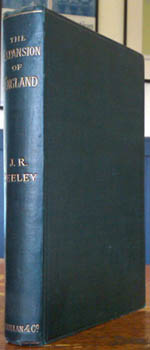
SEELEY, J.R. The Expansion of England. Two courses of lectures. London, Macmillan 1883. Octavo publisher's cloth; viii,308pp. A grammar school label and small stamp on the endpapers but a very good copy. Au$75
First edition. At first glance one of the less enticing of 'Printing and the Mind of Man' books but Carter and Muir do, as usual, make a cogent case for its inclusion in their list of world-changing books (see PMM 369).
![]()
You can email an inquiry or order securely through antiqbook

BEALE, Lionel S. Life Theories: their influence upon religious thought. London, Churchill 1871. Octavo publisher's brown cloth; xii,97,[2]pp and six coloured plates. Spotting of the endpapers but a nice, bright copy. Au$75
A good example of the weight of authority arrayed against wrong-headed fashion. Beale was no lightweight in the medical establishment and Churchill were authoritive publishers of medical books. Beale stood firm against the germ theory and here he stands firm against physical theories of nature. The coloured plates are from microscope studies (which Beale is possibly now best known for) - evidence that this is no mere theological argument.
![]()
You can email an inquiry or order securely through antiqbook
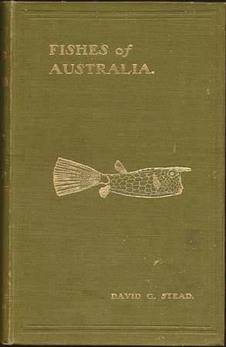
STEAD, David G. Fishes of Australia: a popular and systematic guide .. Sydney, Brooks 1906. Octavo publisher's gilt cloth; xii,278pp, 10 plates, 88 illustrations through the text. A withdrawn Royal Society stamp on the front fly, no other markings and a rather good copy. Au$40
![]()
You can email an inquiry or order securely through antiqbook
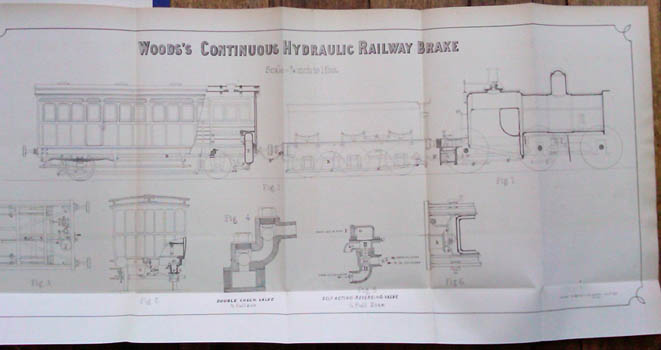
Railways. Woods' Continuous Automatic Brake. [Two reports]. Melbourne, Government printer 1880. Foolscap, the two together in plain modern wrapper; 5pp & 3pp and a long folding plate. Top inner corner torn away from the first report, still in good, fresh shape. Au$90
Continuous brakes - a brake that could be applied to all carriages at the same time by the engine driver - are at this time a new thing. The first report is the Locomotive Engineer's report on the comparative tests between the Australian invented Woods' hydraulic brake and the Westinghouse air brake already installed in some trains. He comes down firmly in both camps and recommends that one be fitted to trains on the northern line and the other to trains on the southern line until either's reliability is proved.
Disputes over the two systems surface in the newspapers for the next five years years then seem to evaporate. Westinghouse air brakes are pretty standard everywhere now and I'd say the wikipedia entry on railway brakes was written by Westinghouse.
![]()
You can email an inquiry or order securely through antiqbook
>Costume. Ladies' Garments and How to Make Them. A practical treatise on the art of sewing, pressing & other details ... as employed by tailors ... by "Several Experts" ... London, John Williamson [c1894]. Octavo publisher's gilt decorated red cloth; [8],80pp, several illustrations and diagrams. Minor signs of use, a rather good copy. Au$150
A slender book maybe, but so packed with information that I wonder how Williamson thought they could justify all the other tailoring books and magazines they published. I can only find much later versions of this - and not many of those - in OCLC and Copac.
![]()
You can email an inquiry or order securely through antiqbook
>Ikeda Eisen [aka Keisei Eisen]. 新版江戶花呉服屋大雙六 [Shinpan Edo no Hana Gofukuya Sugoroku]. [Tokyo], Yamashiroya Matabe [1820 - 1850?]. Woodblock print 67x46cm, printed in black, blue and pink; folded. Smudges and soiling, a couple of small chips from the top edge. A pretty decent copy, certainly better than the only other copy I've located. Au$1,250
Another lesson, if we need it, that the Japanese had connected and mastered the important stuff of life long before the rest of us: advertising, fun and shopping. In this sugoroku - a racing game - Eisen takes us through the most prestigious dry goods stores and drapers - ie high fashion - of Edo (Tokyo) until we reach Ebisu and Daikokuten - gods, respectively, of merchants and wealth. In other words, who isn't this game for? Every working Edo inhabitant with a speck of ambition will want a place among the great merchants, rubbing shoulders with such gods while their wealthy patrons have confirmed that their shopping habits are blessed by the gods. The titans of fashionable commerce here include Echigoya (now Mitsukoshi), Shirokiya (which lasted some three hundred years, its ghost is a department store in Honolulu), Iwaki Sotoya, Matsuzakaya (still going), Ebisuya, Daimaru (still going), Shimaya, Sawanoi and Izukura.
Eisen did more than one sugoroku: this, one of more prosaic sights of Edo, one of the Tokaido road, and an elaborate sort of fourth one - the set of courtesan prints which together form a game - are the ones I've traced. I can only find one other copy of this shopping adventure, printed in yellow rather than blue, in the UC Berkeley library.
*Click on the picture to a couple more.
![]()
You can email an inquiry or order securely through antiqbook
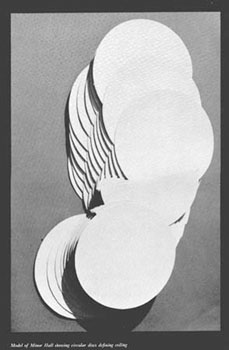
Jorn Utzon. Zodiac 14. Milan 1965. Quarto publisher's illustrated wrapper; 216pp and illustrated adverts; numerous photo illustrations, plans &c. Au$150
Zodiac 14 can be called the Utzon Number. Though he doesn't fill the issue he does dominate it with Giedion's 'Jorn Utzon and the Third Generation' and his own descriptions of the Sydney Opera House, the Silkeborg Museum and the Zurich Theatre. Elements of the Opera House, like the plywood interior of the auditorium, the corridors and the glass walls, which were tentative or unresolved in the 'Yellow Book' are explained in detail here, Utzon's last publication while still architect for the Opera House.
![]()
You can email an inquiry or order securely through antiqbook
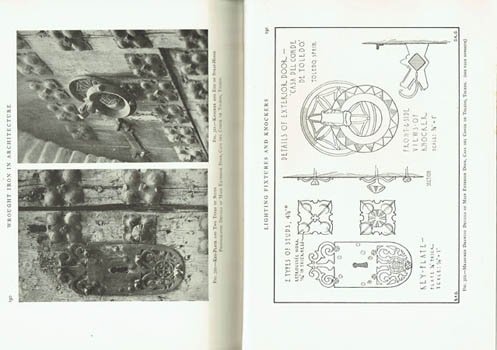
GEERLINGS, Gerald K. Wrought Iron in Architecture ... craftsmanship, historical notes and illustrations .. modern wrought iron, lighting fixtures ... specifications. NY, Scribners 1927. Quarto publisher's cloth, very good in insect chewed dustwrapper; 202pp, numerous photo illustrations, measured drawings &c. Au$75
![]()
You can email an inquiry or order securely through antiqbook
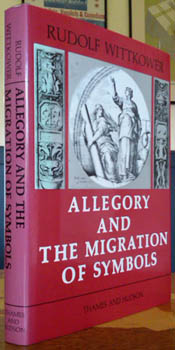
WITTKOWER, Rudolf. Allegory and the Migration of Symbols. Thames & Hudson 1977. Small quarto, excellent in publisher's cloth and dustwrapper; 223pp, 251 illustrations. Au$75
![]()
You can email an inquiry or order securely through antiqbook
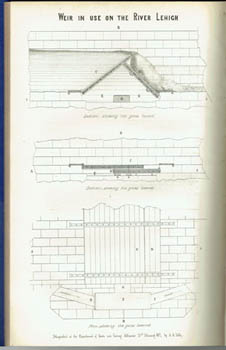
Murray River. Report of the Royal Commission ... to examine into and report upon the best means of Clearing the River Murray, etc. Melbourne, Government printer 1867. Foolscap, plain modern wrapper; 100pp, five full page or folding diagrams. Title a touch dusty, still an excellent copy. Au$120
The first of umpteen commissions and inquiries into the river. There must be more poorly timed Royal Commissions than this but I can't think of any. The Commission was instituted in 1866 and reported in February 1867. Three of the four commissioners unhesitatingly endorsed the Victorian government's current practice but one, John Orr, wrote a stern protest, more or less saying the others didn't know what they were talking about. The flood season a few months later brought the flood that still has a high standing in the record books. The one inarguable benefit from this commission was the first thorough survey of the river, from Albury to Wentworth.
Orr makes the point that a good starting point in the general desire for federation of the colonies would be N.S.W. and Victoria agreeing to set up a trust to manage the river. Such an agreement was made in 1960.
![]()
You can email an inquiry or order securely through antiqbook

Queensland. Socialism at Work. How the Queensland Government succeeded in profitably establishing state ventures where the needs of the people ... Brisbane, Govt Printer 1918. Octavo publisher's printed wrapper (chipped and detached); 136pp, photo illustrations. An ok copy. Au$30
The triumphs of the Ryan government, the start of a long run of Labor in power. Surely no government these days could so flagrantly use public resources to advertise their successes in an election year.
![]()
You can email an inquiry or order securely through antiqbook

Socialism. Socialist Theory Series No.1. Political Economy. Beginner's Course. Sydney, Modern Publishers [193-?]. Octavo publisher's printed wrapper; 48pp including five blank pages for notes. Au$25
Looking curiously like a confectionary box this a catechism in 56 questions and answers. There is a smaller edition of this which I presume is later.
![]()
You can email an inquiry or order securely through antiqbook
>観察絵本 - キンダーブック [卜ケイ] [Kansatsu ehon - Kinda bukku - boku kei]. Tokyo, Fureberukan 1932 (Showa 7). Oblong folio, 26x38cm; 16pp including covers, all colour lithographs on light card. Covers dusty with some smallish flaws to the back cover; used but a very acceptable copy. The publisher's colophon, in a corner of the back cover, is framed in a small clock face and an owner has neatly numbered the clock and put hands in at 3 o'clock. Au$350
Telling the time for kids, one in a series of "observation" books begun in 1927 by the now named Froebel-kan - based on the principles of educator Friedrich Froebel. I've found images of a few of these early books and this is the most stylish by miles. The Fureberukan has published magazines and squillions of worthy books since then, still does, and they look pretty revolting. This one steps into nauseating cuteness here and there but the good plates more than make up for it. I can't find a record of this anywhere.
*Click on the picture to see more in the gallery.
![]()
You can email an inquiry or order securely through antiqbook
>Children's ABC. All Aboard ABC. London, Dean & Son [c1905]. Folio (37x26cm), covers and ten colour pages by Frank M. Barton mounted on card and bound as a concertina. Someone has taken Dean's declaration "untearable" as a challenge and managed to put a two inch tear into the top of one card, without loss; in all rather good. Au$300
A delightfully large celebration of transport and movement with a bas relief front cover. Only a couple of letters display some clutching at straws - Q is for quickness and Z is for zebra cart, and no book is ever debased by the presence of zebras.
![]()
You can email an inquiry or order securely through antiqbook

